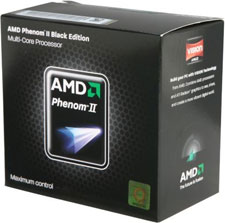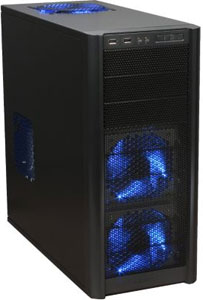Holiday 2010 System Builder's Guide
by AnandTech Staff, edited by Jarred Walton on November 19, 2010 2:00 AM EST- Posted in
- Guides
- Systems
- Holiday 2010
| Jarred's AMD Budget Gaming System | ||
| Hardware | Component | Price |
| Processor |
AMD Phenom II X4 965 Black Edition (Deneb 45nm, 3.4GHz, 4x512KB L2, 6MB L3, 125W) |
$166 |
| Motherboard | ASUS M4A88T-V EVO/USB3 (AMD 880G AM3) | $110 |
| Video | ASUS EAH6850 Radeon HD 6850 1GB | $200 |
| Memory |
A-DATA 2x2GB DDR3-1333 CL9 (AD3U1333B2G9-DRH) |
$62 |
| Hard Drive | Western Digital Caviar Black 640GB (WD6402AAEX) | $70 |
| Optical Drive | Samsung 22X DVDRW (TS-H662SA) | $15 |
| Case | Antec Three Hundred Illusion | $70 |
| Power Supply |
Antec BP550 Plus 550W (-$30 Combo) |
$35 |
| Total System Price | $728 | |
When it comes time to put together a PC for friends or family, price is usually a driving factor in every component selection. Depending on what compromises you're willing to make, you can easily get a complete system for under $500 (sans LCD, OS, and peripherals), but if I'm putting together a system I don't want compromises—I want a good PC that I'm confident will last at least three years, barring unforeseen component failures. So, my go-to system tends to focus on balancing price, quality, and performance, which means I check in right around the $500 mark. That's not bad for a PC, but what if you're interested in gaming?
Here's the thing so many people overlook when it comes to gaming consoles. The basic hardware will set you back $300 or less, but you end up occupying the living room, games cost more, and if you want to do things like surf the Internet, type a report, email, print, etc. you still have to have a PC somewhere in the house. So take your standard home/office PC, make sure you have a few upgrade options available (i.e. don't buy one of those ultra-budget systems with a tiny power supply, cramped chassis, and no PCIe x16 slot), and then you go out and buy a decent graphics card. Even the $115 graphics cards pack plenty of performance (i.e. the GeForce GTS 450), but for serious gaming you should plan on spending more like $200 and getting a GTX 460 or HD 6850. That's what I've done here, with a few other noteworthy extras.

First, notice the CPU: AMD's Phenom II X4 965 Black Edition. The stock 3.4GHz clock is already more than fast enough for any games, but the Black Edition means you can play around with overclocking without needing to raise bus or memory speeds. Sure, Intel has faster processors available, but for less than $200 it's going to be very difficult to match the performance of the Phenom II 965!
With an AMD CPU and motherboard chipset, $10 more gets you basic CrossFireX support—in this case courtesy of the ASUS M4A88T-V. You also get native SATA 6.0Gbps ports from the chipset and USB3.0 ports, so you've got just about everything you need to last you through the next two generations of hardware. And if games get to the point where a single 6850 can't handle your chosen resolution/settings, you can grab a second card and boost your performance! If you're serious about the CrossFireX route, though, you might want a motherboard with dual x8 PCIe slots as opposed to the x16/x4 on the selected ASUS board, in which case you're looking at another $20 to get something like the Gigabyte A-890GPA-UD3H.
As far as the GPU goes, the video card I selected is AMD's latest Radeon 6850, which is roughly on par with NVIDIA's GeForce GTX 460 1GB. Honestly, I would probably lean towards the latter on an Intel setup, but getting SLI support on an AMD platform is becoming rather difficult and pairing the AMD CPU with an AMD GPU has a nice symmetry to it. I'd suggest 1080p and high details as reasonable for the 460 and 6850, but you'll need to turn off antialiasing in some titles to get acceptable performance. The 6850 GPU I selected also comes from ASUS, by virtue of the fact that it was the quietest card in our 6850 roundup.

Some enthusiasts like to stay on the cutting edge, but that costs more money and the net difference often isn't worth the price of admission. I've been running an Intel Kentsfield processor at 3.2GHz for the past three years as my primary system (about the same performance as the Phenom II 965), and while I have a faster Core i7 desktop available I honestly don't notice the difference in most tasks. Gaming depends primarily on your GPU (unless you have a really slow CPU like Atom), so that's where you need to focus your money. You could even go with a cheaper CPU like the Athlon II X4 645 or the Phenom II X4 810, but as you can see from the linked results the overall performance drop likely isn't worth the money saved—especially if you want to upgrade to CrossFire down the road. Also worth noting is that there are games that hit the CPU quite hard (StarCraft II in large battles is particularly brutal), so don't skimp too much.
The rest of the components I've selected are still good in their own right, and there are plenty of sales and combo offers right now. If you have a bit of extra money left over, adding a moderate 64GB SSD as your OS/application drive is certainly worth doing, but with a focus on keeping costs down and gaming performance up, I left it out (and I'm sure others will include it). If you want an alternative to my selection, you could even go with the winning Newegg EggXpert PC SuperCombo (which has quite a few similarities to my build). Just add an OS, display, keyboard, and mouse and you're golden!










112 Comments
View All Comments
prdola0 - Friday, November 19, 2010 - link
In some of the systems, I would buy a GTX460 1GB instead of the HD6850 simply because most people play in 1920x1200 and lower (I would say 1680x1050 as the most common) and in those resolutions the GTX460 is better than the HD6850. It would be also a choice for the next generation of games, if the consoles ever let it come. Otherwise very nice systems.One question though, are all those memories you guys used from QVLs of the motherboards or do you just trust them?
Thanks a lot,
Prdola
ganeshts - Friday, November 19, 2010 - link
The components suggested in my mid-range HTPC build are all tried and tested together :)therealnickdanger - Friday, November 19, 2010 - link
It would be cool if each of these builds was benched and the results were shown... :) I know that's asking a lot, but like Brian said:"Heck, there's no reason you can't at least ask for the absolute best..."
AnnihilatorX - Saturday, November 20, 2010 - link
I'd personally go for HD6850. It runs cooler, uses less power, can double up as high quality sound card (if you have a AV receiver with HDMI, Radeon HD68xx support DTS Master HD, etc).prdola0 - Monday, November 22, 2010 - link
The GTX460 can of course also double up as a high quality soind card. Why wouldn't it?blotto5 - Saturday, November 20, 2010 - link
for 1680x1050 it does perform better, but not by much. for 1920x1200 there is almost no difference, and for any resolution higher than that the 6850 blows it out of the water. when your have an amd processor and an amd chipset it would make sense to stay on the same platform and get an amd video card, everything plays nice together that way.prdola0 - Monday, November 22, 2010 - link
Any nVidia graphics card will work just as good on an AMD system as on an Intel system. How did you find that it wouldn't? That's totally false.And your statement about no difference in 1920x1200 is only valid for the GTX460 768MB. The 1GB version is actually still better at 1920x1200. According to Steam Survey, 74.2% of players play at 1680x1050 or lower resolution and only 4.19% play at higher resolutions than 1920x1200. I still don't understand why all the reviews focus so much on the 2560x1600 resolution. I wish Ryan didn't ignore that fact in his Final Words. But world isn't perfect :)
Quizzical - Friday, November 19, 2010 - link
If Zambezi isn't going to fit Socket AM3, then someone ought to tell AMD.End of page 5 of the AMD codename decoder that they released on financial analyst day:
“Zambezi”
Market: Desktop
What is it? four-, six-, or eight-core 32-nm AM3 socket desktop processor based on
the “Bulldozer” processor architecture for the enthusiast market.
Planned for introduction: 1H 2011
If I give a link, this site apparently flags the comment as spam and disallows it. But you can find it yourself as follows. Do a Google search for "AMD 2010 Financial Analyst Day". Click the (currently) top search result, to a page on AMD's site with that headline. Click the "AMD Codename Decoder" link from that page. The above is a copy and paste from the end of the document.
Dustin Sklavos - Friday, November 19, 2010 - link
Later on in the year they did say they tried to make Bulldozer compatible with the existing AM3 socket but couldn't do it, as a result you get AM3r2, where the motherboards will be backwards compatible with old AM3 chips, but the Bulldozer chips aren't going to be compatible with old AM3 boards.Quizzical - Friday, November 19, 2010 - link
The information I quoted was released by AMD last week. "Later on in the year" than that would have to be very, very recent. As I said, if the information that AMD just released is wrong, someone should tell them to fix it.